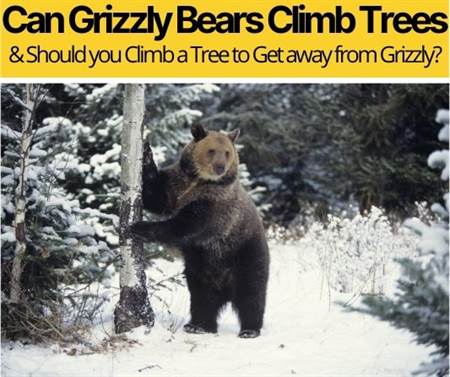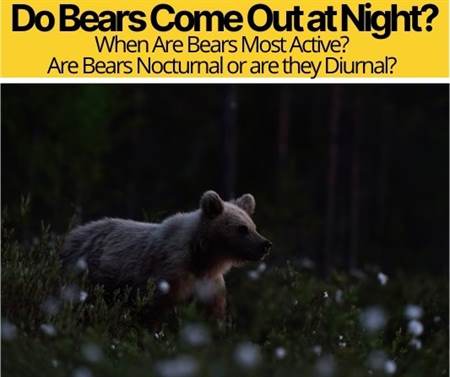 Have you ever wondered if bears can climb trees?
Have you ever wondered if bears can climb trees?
Perhaps you’ve pondered how such a large animal could climb up a tree, or even stay up there.
Why would they want to? Is this something all bears are skilled in?
This article will answer all of these questions and provide a deeper look into why or how a bear might climb a tree.
Make sure to read on to find out if you should climb a tree during a bear encounter, or if you should just stay safely on land instead.
Can Bears Climb Trees?
Yes, Bears can climb trees, and some of them are quite skilled at it, too. However, some bear species excel at tree climbing more than others.
For some bear species their age, size, and height determine how well they can climb trees or if they do so at all.
Read on to find out if your favorite species of bear is an expert tree climber, and which species is the best at climbing trees.
How do Bears Climb Trees
Some bears can climb extremely well using a combination of well-structured claws, strong muscles, and strategic methods.
The black bear, which is known for its agile climbing of trees, has a special technique making use of its hooked claws.
While gripping with their front legs, black bears can push themselves up with their hind legs. When climbing down, their body remains in this position, and they can shimmy themselves down the tree.
Larger bears, such as grizzlies, need to find a different way up and down trees. Grizzly bears strategically use thick branches that can support their weight to hoist themselves up as they climb.
Cubs learn to climb trees from their mothers, and it’s an impressive skill.
Adult bears may or may not continue climbing trees later in life due to size, weight, or necessity.
Also read: How do Bears Hibernate
Why Do Bears Climb Trees
The primary reasons a bear might climb up a tree are for rest, food, or safety.
Although bears do not live in trees, they have been known to climb up for a nap. All bears are omnivorous, so even though they hunt prey, they also love the nuts and fruit they can reach while in the tree-tops, and they can find many snacks up high.
While bears love the sweet treats they find in trees, they may also climb for safety. Up and away from land predators, hiding in a tree is relief from danger for a bear and especially for her cubs.
Whatever the reason may be for a bear to climb trees, each species of bear does it a little differently.
Let’s take a look at some common species of bears and break down their strengths and weaknesses when climbing trees.
Can Black Bears Climb Trees
This smaller-sized bear is a well-equipped climber and can climb up a tree with great agility and ease at one hundred feet in thirty seconds.
The Black Bear may be reaching for his favourite fruits, nuts, or berries, or they may even be able to swipe eggs from a bird’s nest. If the black bear is climbing a tree but isn’t looking for food, she might be up there to escape a predator.
If she has cubs, they will climb up a tree, ensuring their safety. The mother bear will request to her cubs that they climb. The cubs will follow their mother’s orders; they know she knows best.
Can Brown Bears Climb Trees
Larger, adult brown bears, found closer to the coast, don’t climb as often as black bears, mostly due to their size.
Younger brown bears can still climb trees to capture certain prey, though, and females may also climb from time to time. It’s not likely that you’ll spot a male brown bear up high though – they’re pretty large!
Since they’re too heavy to climb the same way black bears do, brown bears use tree branches to their advantage when they do climb.
Tree branches can function as steps, and this eases the climb for brown bears.
Can Grizzly Bears Climb Trees
These giant inland bears may be heavy, but grizzly parents make sure all their cubs learn to climb! Grizzly bears become enormous as they grow older though, so not all adults continue to climb.
Those that do climb need to rely on branches the way other brown bears do. In addition to their massive size, grizzly bears have a claw structure that isn’t conducive to climbing.
Their claws straighten out as they grow older. With that said, a grizzly bear can still climb a tree if one wants to.
Can Polar Bears Climb Trees
It may surprise you to know that these arctic species do climb trees, just not as often as other bears due to their barren environment.
While polar bears are used to climbing snowy, mountainous cliffs, there are fewer trees in their habitat than other bear species.
Polar cubs can be seen climbing smaller trees on their icy terrain. The adults simply lack the same durability in their claws, and they would need more trees to practice on!
Can Panda Bears Climb Trees
Understanding the climbing skills of pandas isn’t black and white. Panda cubs learn as young cubs, but some pandas seem to be better at climbing trees than others.
It’s not unusual to see one accidentally fall from a tree, too! Once a young panda can climb, they stay safely in the trees when their mother leaves to gather food.
Pandas have short, stocky limbs, so some pandas use their neck to allow grip with their head, making them only one of two types of animals to do so.
Can Sloth Bears Climb Trees
These bears share more with sloths than just the name. The India-native sloth bear is also an excellent climber thanks to its long hooked claws.
They are versatile and agile in their climbing abilities. They can climb rough or smooth bark, and they can even hang upside down from a branch.
The sloth bear will help himself to a snack by knocking down honeycombs from trees and then retrieving the honey from the ground below.
Can Sun Bears Climb Trees
This petite bear with unique chest colouring is not only the smallest in the world but the aptest at climbing trees.
It doesn’t take long after birth for cubs to learn how to climb. High up in the trees is where you’ll spot a sun bear.
They spend much time there in nests built from leaves and branches, especially when they sleep. Sun bears are practically built for climbing with their small bodies, evolved claws, and even sharp teeth that help them climb.
For Sun bears, the trees are the best place to escape predators, enjoy rest, and live happily!
Should you Climb a Tree When a bear is Chasing You?
As you can tell, bears are well-equipped with climbing skills, so it is not wise to climb up a tree if you’re trying to escape from a bear.
If you’re being threatened by a bear, you should avoid running at all.
Bears are extremely fast runners and they will feel impelled to chase and catch up to you, and you don’t want to be in the company of an angry bear!
However, bears are usually only angry when they feel provoked or threatened.
Most bears don’t want to attack you instinctively, so there are a few solutions to avoid a bear attack:
- Pick up all small children in the area and remain calm throughout the encounter.
- Don’t drop or offer up your food.
- While speaking in a low, unnerving voice to ease the situation, use side-steps to leave the encounter.
- Don’t run if the bear begins to follow. Instead, stop, and continue remaining calm until you can flee the situation.
On the slim chance that you find yourself in a bear attack, there are safety precautions you can take depending on the type of bear. Black bear attacks can best be thwarted by striking their face and snouts.
When possible, escape to the nearest building.
Brown bears and grizzly bears should not be counter-attacked. Instead, play dead on your stomach with your legs out and your hands behind your neck.
If you have food, allow the bear to take it, and wait until you can safely flee.
Conclusion
Though bears climb trees often, no species of bears are known to live in trees.
However, there is a marsupial species with teddy bear-like features that live in the tree-tops. The lovable tree kangaroos, found in and near Australia, are the closest natural resemblance to a bear living in a tree.






